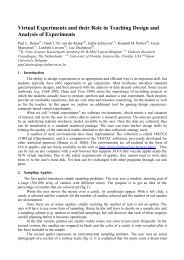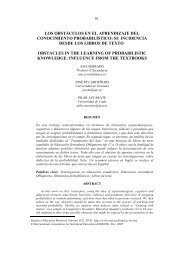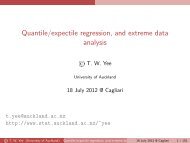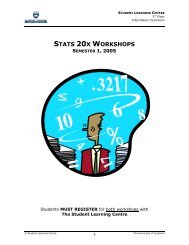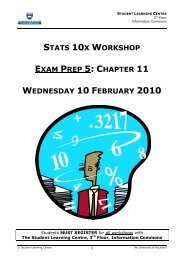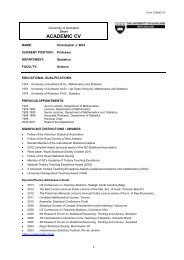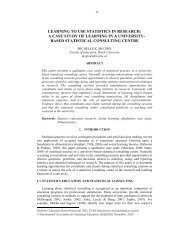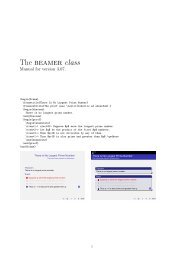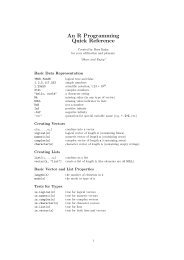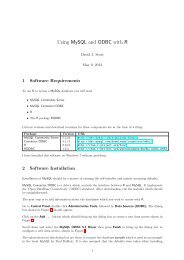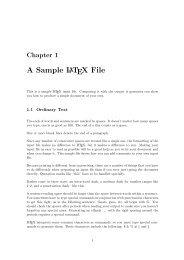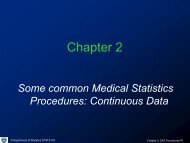modeling the growth of students' covariational reasoning during an ...
modeling the growth of students' covariational reasoning during an ...
modeling the growth of students' covariational reasoning during an ...
You also want an ePaper? Increase the reach of your titles
YUMPU automatically turns print PDFs into web optimized ePapers that Google loves.
20<br />
status in <strong>reasoning</strong> about bivariate data. The estimated average initial score for students<br />
who show average ch<strong>an</strong>ge in <strong>the</strong>ir <strong>reasoning</strong> about univariate data is 0.86 (p < 0.0001).<br />
The estimated strength <strong>of</strong> association between initial BR scores <strong>an</strong>d centered DR scores is<br />
0.13 (p < 0.01). This result suggests that on average, <strong>the</strong>re is a positive relationship<br />
between initial BR scores <strong>an</strong>d centered DR scores indicating that students who exhibit<br />
larger th<strong>an</strong> average ch<strong>an</strong>ges in <strong>the</strong>ir <strong>reasoning</strong> about univariate distribution also tend to<br />
have higher initial levels <strong>of</strong> <strong>reasoning</strong> about bivariate data. Differences between students’<br />
ch<strong>an</strong>ge in <strong>reasoning</strong> about univariate distribution on average tends not to be associated<br />
with ei<strong>the</strong>r linear or quadratic rates <strong>of</strong> ch<strong>an</strong>ge in <strong>reasoning</strong> about bivariate data<br />
throughout <strong>an</strong> introductory statistics course. A visual depiction <strong>of</strong> this model is shown in<br />
Figure 3.<br />
Figure 3. Predicted average ch<strong>an</strong>ge in qu<strong>an</strong>titative bivariate <strong>reasoning</strong> for students<br />
with small, moderate, <strong>an</strong>d large ch<strong>an</strong>ges in <strong>the</strong>ir <strong>reasoning</strong> about distribution<br />
5. DISCUSSION<br />
This study examined <strong>the</strong> development <strong>of</strong> students’ <strong>reasoning</strong> about bivariate data<br />
over a 15-week introductory college statistics course. Three research questions were<br />
examined <strong>an</strong>d used to structure <strong>the</strong> collection <strong>an</strong>d <strong>an</strong>alysis <strong>of</strong> data. The <strong>an</strong>swers to each<br />
question are summarized below.<br />
5.1. WHAT IS THE NATURE, OR PATTERN OF CHANGE IN STUDENTS’<br />
DEVELOPMENT IN REASONING ABOUT QUANTITATIVE BIVARIATE<br />
DATA THROUGHOUT AN INTRODUCTORY STATISTICS COURSE?<br />
Student data collected over <strong>the</strong> semester revealed marked <strong>growth</strong> in <strong>reasoning</strong> about<br />
bivariate data but this happened primarily in <strong>the</strong> first time period. The LMM that was<br />
adopted to examine this <strong>growth</strong> suggested that students exhibit both linear <strong>an</strong>d quadratic<br />
<strong>growth</strong> in <strong>the</strong>ir development about <strong>reasoning</strong> about bivariate data <strong>an</strong>d that this <strong>growth</strong><br />
varies among individual students. A quadratic model indicates that students’ <strong>reasoning</strong><br />
about bivariate data does not increase in a const<strong>an</strong>t linear fashion, but instead increases<br />
differentially over time. The signific<strong>an</strong>t negative quadratic term suggests that although<br />
students initially show great strides in <strong>the</strong>ir <strong>reasoning</strong> about bivariate data, <strong>the</strong>y likely<br />
eventually pl<strong>an</strong>e <strong>of</strong>f in this development <strong>an</strong>d over time might actually even regress –<br />
although given <strong>the</strong> paucity <strong>of</strong> measurement occasions used in <strong>the</strong> study, this regression



